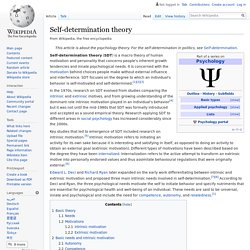

21 Self-Determination Skills and Activities to Utilize Today. How do we move ourselves – and others – to act?

It all hinges on motivation. People are often motivated to act by external influences, be they financial reward, prestige, advancement, or the opinions of others. Yet, just as often, people are motivated from within, by their beliefs and personal values. While extrinsic motivation is not necessarily a bad thing, it is intrinsic motivation that most effectively encourages and sustains action.
We need to feel autonomous – that we are the authors and agents of our behavior rather than feeling that external forces control our behavior. Self-Determination is primarily concerned with intrinsically driven motivation and shines a light on the interplay between the external factors and internal motives inherent in human nature. The following article will examine the concept of self-determination, answer common questions on the subject, and take a look at some activities, assessments, and worksheets to develop and improve self-determination skills. 1.
What is Self-Determination Theory? (+PDF) The Vital Importance and Benefits of Motivation. Being passive is not our default mode as human beings.

Otherwise, we would have been born as a slough or a panda bear (no offense to these lovely creatures). It is in our nature to strive, to want, and to move in a direction of something we desire and deem valuable. Action may not always bring happiness, but there is no happiness without action. William James This article explains the reasons why understanding human motivation is important and well worth the time spent on learning to increase it. Self-determination theory. Self-determination theory (SDT) is a macro theory of human motivation and personality that concerns people's inherent growth tendencies and innate psychological needs.

It is concerned with the motivation behind choices people make without external influence and interference. SDT focuses on the degree to which an individual's behavior is self-motivated and self-determined.[1][2][3] In the 1970s, research on SDT evolved from studies comparing the intrinsic and extrinsic motives, and from growing understanding of the dominant role intrinsic motivation played in an individual's behavior[4] but it was not until the mid-1980s that SDT was formally introduced and accepted as a sound empirical theory. Research applying SDT to different areas in social psychology has increased considerably since the 2000s.
Basic theory[edit] SDT identifies three innate needs that, if satisfied, allow optimal function and growth: Competence[9][10]Relatedness[11]Autonomy[12][13] Needs[edit] Competence Relatedness. Why Paying Fixed Bonuses is Hurting Your Business. Hi there!

My name is Sina. Among other things, my mission is to make Blinkist the best place to work in Berlin. Tasked with reviewing our incentive strategy, I realized something: we were doing it wrong—and everybody else is, too. In many industries it’s common practice to award employees a contractual bonus in the form of an annual one-time payment, tethered to company KPIs.
It’s actually so commonplace that many founders introduce these same old corporate procedures in their otherwise modern and progressive ventures. Unfortunately, what’s good for the goose isn’t always good for the gander. As I researched and read, building a case for a new incentive system we’re just about to implement at Blinkist, I found lots of reasons startups and younger companies shouldn’t be using old bonus systems. Where’s my bonus? The first time around, people will get excited about receiving their bonus. You’re not holding that carrot right The wrong kind of retention Make an effort, but do it well.
Extrinsic Rewards. Self-Motivation. Self-Discipline. Self-Management. Internal Vs. External Motivation: How To Build An Exercise Routine You’ll Stick To. This article was originally published at Riskology.co On my running routes, there are a few folks — the regulars — I can always count on seeing.

We don’t know each other, but we wave and say “hi.” I like to add, “Enjoy the run!” For good measure. “Thanks, I always do!” I was talking to a friend about exercise recently and how it can be so hard to get yourself into any kind of rhythm that fits into a productive routine. That reminded me of those daily micro-exchanges: “Enjoy the run!” That’s not just a formality. If you’ve ever struggled to stick to a fitness plan — or any plan, really — the solution could be as simple as channeling your motivation from the right source.
Internal Vs. Talk to someone who works with drug rehab patients, and you’ll hear the same wisdom shared over and over: “Success depends on your motivations.” And what are the right reasons? That example illustrates the difference between internal and external motivation. Let’s face it. Only do exercise you enjoy. Self-Concept. Self-Management.